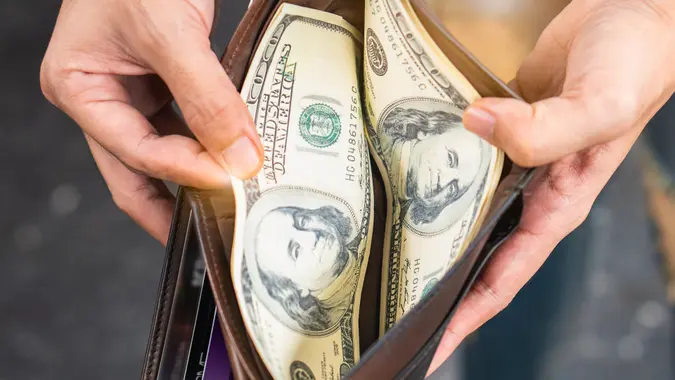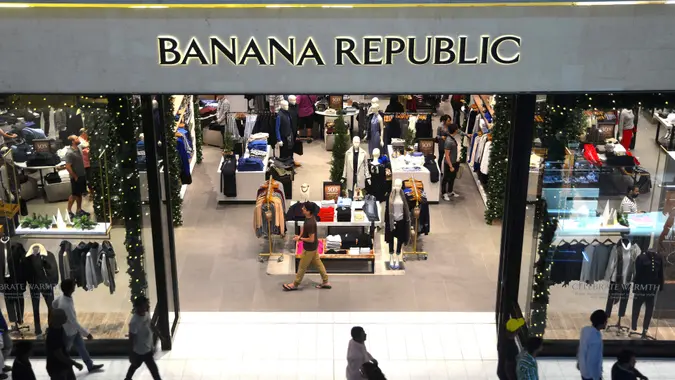The $1 Rule: A Simple Way To Fix Your Spending Habits

Commitment to Our Readers
GOBankingRates' editorial team is committed to bringing you unbiased reviews and information. We use data-driven methodologies to evaluate financial products and services - our reviews and ratings are not influenced by advertisers. You can read more about our editorial guidelines and our products and services review methodology.

20 Years
Helping You Live Richer

Reviewed
by Experts

Trusted by
Millions of Readers
Careful spending doesn’t have to mean avoiding every splurge and always buying the cheapest option. According to some budget experts, that approach might even hurt your wallet in the long run.
Personal finance influencer Bernadette Joy recommends an alternative method called the $1 rule. It doesn’t replace careful budgeting, but it can help you spend more thoughtfully.
What Is the $1 Rule?
The $1 rule is simple: If something will cost $1 or less per use, it’s okay to buy. A $10 item should get at least 10 uses. A $100 item should get 100 uses, and so on.
The rule is easy to apply. Anytime you want to buy something, ask yourself how many times you’ll use it. This is an effective way to avoid purchases that will detract from your financial goals without much benefit.
Applying the $1 Rule
Joy illustrated her $1 rule using a pair of lavender Nike sneakers that she showed off to her YouTube followers.
They cost $70, but she calculated that she’d wear them about twice a week and easily get more than 35 weeks out of them. That worked out to more than 70 uses, so she bought the shoes, even though it was “a little bit of a pricey purchase.”
Quality Matters
The $1 rule reminds us that quality sometimes costs money, but it’s more sustainable than wasting money on poorly made items. The fast-fashion industry expects consumers to pay $20 for a pair of shoes or a sweater, but items at those bargain price points often don’t last.
In the long run, spending $50 or even $100 on a well-made wardrobe staple is better than replacing your $20 shoes every time they fall apart. And classic items stay fashionable longer, so you don’t need to sacrifice style for budget.
Buying Higher-Ticket Items
The $1 rule works well for more significant purchases, like appliances and technology. It motivates you to consider what you need from a purchase and what’s worth the cost.
Take your phone, for example. It’s tempting to buy the latest model with all the bells and whistles, but will you do the same thing when the next update comes out?
If you think of each day with your phone as one use, you should get three years out of your $1,000 phone if you follow the $1 rule. Instead of falling prey to advertising, save for your next model and buy one that will last.
Handling Exceptions
The $1 rule applies primarily to discretionary consumer spending. As financial columnist Lesley-Anne Scorgie recently told Toronto Star readers, some things have more value than their number of uses.
In this case, think of the spirit of the $1 rule. Will your vacation memories last longer than it took you to pay for the trip? The answer will probably be different for “special” experiences than for a more affordable weekend getaway, which might not be worth the cost of the bargain motel.
The $1 rule is all about spending on what matters, not holding your purse strings as tightly as possible. It’s about using your money for items and experiences that add value to your life.
Thoughtful Spending, Not Spending Guilt
Joy developed the $1 rule to offer “permissions, not restrictions.” It’s an alternative to restriction-based budgeting strategies that make you feel guilty about every purchase so that you’ll do anything to avoid spending money.
The $1 rule lets you spend money on things that bring you joy. There’s even room for exceptions for purchases that significantly improve your life.
Of course, like with any good budgeting rule, you still have to be able to afford what you buy — $1-per-use buys and joyful exceptions work only if you have the money. If you don’t, it’s not a “forever no” — just a no until you’ve saved up.
Work the purchase into your budget. If you still want it when you’ve saved up enough, you can then go for it, guilt-free.
More From GOBankingRates
 Written by
Written by  Edited by
Edited by 

























